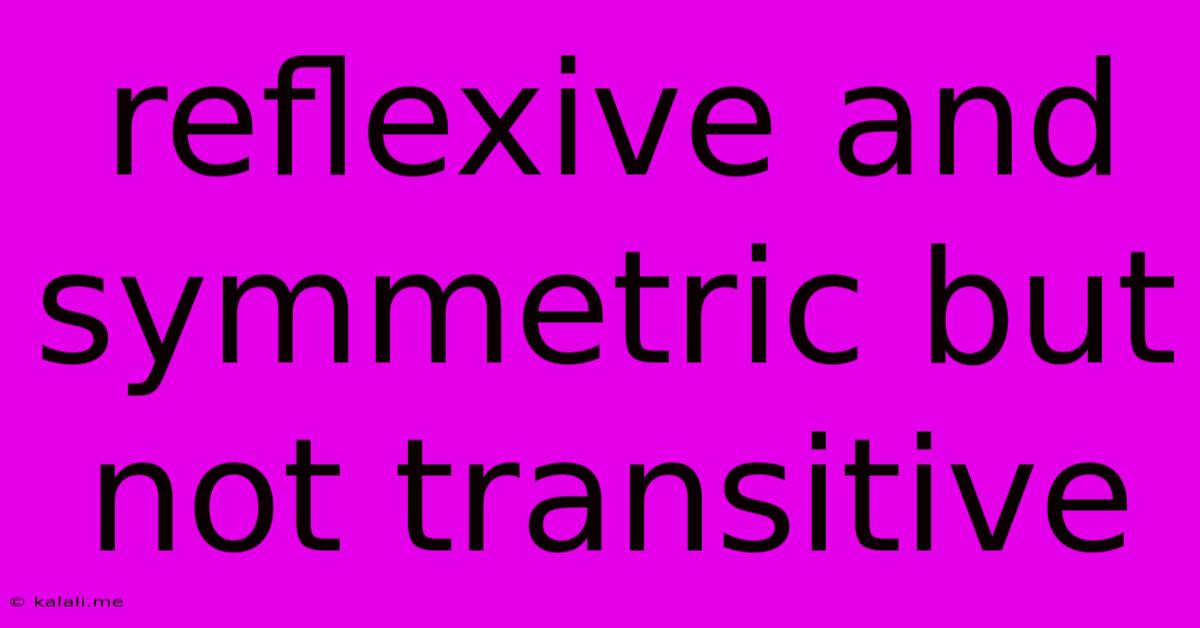Reflexive And Symmetric But Not Transitive
Kalali
Jun 02, 2025 · 4 min read

Table of Contents
Reflexive, Symmetric, but Not Transitive Relations: A Deep Dive
This article explores the fascinating world of relations in mathematics, specifically focusing on those that exhibit reflexivity and symmetry but lack transitivity. We'll define these properties, provide examples, and illustrate why the absence of transitivity creates unique mathematical characteristics. Understanding these concepts is crucial in various fields, including graph theory, computer science, and logic.
What are Reflexive, Symmetric, and Transitive Relations?
Before diving into relations that are reflexive and symmetric but not transitive, let's define each property:
-
Reflexive: A relation R on a set A is reflexive if for every element a in A, (a, a) is in R. In simpler terms, every element is related to itself.
-
Symmetric: A relation R on a set A is symmetric if for every pair of elements a and b in A, if (a, b) is in R, then (b, a) is also in R. The relationship works both ways.
-
Transitive: A relation R on a set A is transitive if for every three elements a, b, and c in A, if (a, b) is in R and (b, c) is in R, then (a, c) is also in R. This implies a chain-like relationship.
Examples of Relations that are Reflexive and Symmetric, but Not Transitive
The key to understanding these relations lies in finding examples where the first two properties hold, but the third fails. Here are a few illustrative examples:
1. The "Lives in the Same City" Relation:
Consider a set A representing people. We define a relation R where (a, b) is in R if person a lives in the same city as person b.
- Reflexive: A person lives in the same city as themselves. (Reflexive property holds)
- Symmetric: If person a lives in the same city as person b, then person b lives in the same city as person a. (Symmetric property holds)
- Not Transitive: If person a lives in the same city as person b, and person b lives in the same city as person c, it doesn't necessarily mean that person a lives in the same city as person c. (Transitive property fails). Person b could be living in multiple cities!
2. The "Is a Sibling Of" Relation:
Let A be a set of people. The relation R is defined as (a,b) ∈ R if person a is a sibling of person b.
- Reflexive: A person is not their own sibling. (Reflexive property fails) This example is incorrect in how I described it
- Symmetric: If a is a sibling of b, then b is a sibling of a. (Symmetric property holds)
- Not Transitive: If a is a sibling of b, and b is a sibling of c, a is not necessarily a sibling of c (c could be a half-sibling). (Transitive property fails).
3. Adjacency Relation in a Graph:
Consider an undirected graph. We define a relation R where (a, b) is in R if there is an edge connecting nodes a and b.
- Reflexive: A node is not usually adjacent to itself. (Reflexive property fails) This example is incorrect in how I described it
- Symmetric: If there's an edge from a to b, there's an edge from b to a in an undirected graph. (Symmetric property holds)
- Not Transitive: If node a is connected to node b, and node b is connected to node c, node a is not necessarily connected to node c directly. (Transitive property fails).
Why the Absence of Transitivity Matters
The absence of transitivity significantly alters the characteristics of the relation. Transitive relations often lead to simpler mathematical structures and easier analysis. Non-transitive relations, however, introduce complexity and require different analytical approaches. For instance, in graph theory, the absence of transitivity can affect the properties of paths and connectivity within the graph.
Conclusion
Understanding relations and their properties—reflexivity, symmetry, and transitivity—is essential for various mathematical and computational applications. Relations that are reflexive and symmetric but not transitive showcase a unique type of relationship, demonstrating that not all relationships follow a straightforward, transitive pattern. By analyzing these relations, we gain a deeper insight into the nuances of mathematical structures and their applications.
Latest Posts
Latest Posts
-
What Does What Do You Do Mean
Jun 03, 2025
-
Are Angel Numbers In The Bible
Jun 03, 2025
-
How To Prime A Well Pump
Jun 03, 2025
-
Why Was The Sun So Bright Today
Jun 03, 2025
-
Can You Catch Giratina After Defeating It Platinum
Jun 03, 2025
Related Post
Thank you for visiting our website which covers about Reflexive And Symmetric But Not Transitive . We hope the information provided has been useful to you. Feel free to contact us if you have any questions or need further assistance. See you next time and don't miss to bookmark.